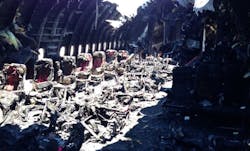Sidestepping safety requirements will end is disaster, aircraft engineers warn
AMSTERDAM, 30 April 2015.Aircraft Engineers International (AEI) officials warn that the air travelling public in Europe is exposed to an increasing risk of injury because European regulators condone he inconsistent and inadequate application of safety regulations.
"Our concern derives from the inconsistent, and in some European countries, inadequate, application by the individual national aviation authorities of safety regulations. The dilution of these regulations by the authorities of those countries presently represents an unacceptable risk of disaster." So reads the AEI’s letter to the European Aviation Safety Agency (EASA).
The risk arises out of the regulations governing the release to service of aircraft after they have undergone maintenance. The rules promulgated and approved by EASA call for work done on aircraft to be checked and signed off by a licenced aircraft engineer whose responsibility it is to certify that the aircraft is fit for service. The relevant regulation states "a Certificate of Release to Service (CRS) shall be issued by appropriately authorised (licensed) staff on behalf of the Organisation when it has been verified that all maintenance ordered has been properly carried out".
AEI has been advised by members that, in certain European countries, EASA approved maintenance organizations have obtained approval for a procedure for the release of aircraft into service which effectively removes the requirement for licensed staff to check the work that has been undertaken by the organizations unlicensed mechanics. These revised procedures simply require the licenced engineer to verify that the unlicensed mechanics have signed off the work that was to be done. The licenced engineers cannot physically inspect and check. In the words of the regulation, there is no verification the work has been properly carried out. This reduces the task of the licensed engineer to a purely administrative "tick box" exercise though they continue to bear the professional, civil, and criminal responsibility by virtue of execution of the CRS for anything which may go wrong subsequently as a result of the unsupervised maintenance.
"This procedure does not represent the verification called for by the regulations nor is it the custom and practice of the industry. Instead it represents a departure from that practice and a serious derogation from it," says AEI's Secretary General Fred Bruggeman. "Such a procedure cuts operator costs by reducing the amount of time spent in maintenance; particularly if the licenced engineer discovers work not performed adequately. This may reduce some delays and save cost but at an unacceptable risk to safety."
AEI urges national regulators and EASA to enforce the rules to which they have subscribed and return safety to the heart of commercial aviation within Europe.
Read the full letter below.
Aircraft Engineers International (AEI) was formed in 1971 and represents the collective interests of over 40,000 Licensed Aircraft Maintenance Engineers in over 30 countries. The AEI mission is to be the global voice of Licensed Aircraft Engineers by providing representation and support in order to promote the highest levels of aviation safety and maintenance standards worldwide.
Mr. Patrick Ky
EASA Executive Director
Postfach 10 12 53
D-50452 Cologne, Germany
28.04.2015
Subject: NON COMPLIANT RELEASE TO SERVICE PROCEDURES
Dear Mr Ky
We write to place on record our belief that the air travelling public in Europe is exposed to an increasing risk
of injury. Our concern derives from the inconsistent, and in some European countries, inadequate, application
by the individual national authorities of safety regulations. The dilution of these regulations by the authorities
of those countries presently represents an unacceptable risk of disaster.
We have taken the advice of Sean Gates, an internationally recognised aviation lawyer on the regulatory and
liability issues arising from the issues in this letter, who supports our view as to the proper interpretation of
the regulations and their consequent erosion in various national arenas.
The risk arises out of the regulations governing the release to service of aircraft after they have undergone
maintenance. The rules promulgated by the International Civil Aviation Organisation and approved by the
European Aviation Safety Agency (“EASA”) call for work done on aircraft to be checked and signed off by a
licenced engineer whose responsibility it is to certify that the aircraft is fit for service. The relevant regulation
(Part 145.A.50(a)) states “a Certificate of Release to Service (CRS) shall be issued by appropriately authorised
staff on behalf of the Organisation when it has been verified that all maintenance ordered has been properly
carried out”.
The administration of regulations within Europe is the responsibility of the Civil Aviation Authority of each
European country. Their function is to approve the procedures proposed by individual operators. The
European Aviation Safety Agency (EASA) periodically audits each Authority to verify that the procedures they
have approved are in order.
We are advised by members that, in certain European countries, Part 145 approved maintenance
organisations have obtained approval for a procedure for the release of aircraft into service which effectively
removes the requirement for Part 66 qualified licensed staff to check the work that has been undertaken by
the organisations mechanics. These revised procedures simply require the licenced engineer to verify that the
unlicensed mechanics have signed off the work that was to be done. The licenced engineers cannot physically
inspect and check. In the words of Part 145, there is no verification the work has been properly carried out.
This reduces the task of the licensed engineer to a purely administrative “tick box” exercise though he
continues to bear the professional, civil and criminal responsibility by virtue of execution of the CRS for
anything which may go wrong subsequently as a result of the unsupervised maintenance.
This procedure does not represent the verification called for by Part 145 nor is it the custom and practice of the industry. Instead it represents a departure from that practice and a serious derogation from it. Such a procedure cuts the operators costs by reducing the amount of time that may be spent in maintenance;
particularly if the licenced engineer discovers work not performed adequately. This in turn may lead to delays
in operation, some of which may give rise to the airline suffering additional costs because of its strict liability
under the European regulation imposing liability on carriers for delays. This should not be an adequate reason
for safety itself to be compromised.
It is not clear to us how the procedures adopted by the national authorities we have mentioned can have
successfully been audited by EASA although EASA has publicly complained of inadequate funding and staffing.
There is, however, no check on EASA’s performance itself in this context. Therefore there is no effective
alternative for us to raise this issue other than by this formal letter in which we hope to warn of the possible
consequences of the current dilution of safety regulations within Europe.
Of course we hope that that derogation from Part 145 will not result in a fatal accident but instead to a review
of the audit procedure itself and of the regulations of those States which we believe are currently in breach of
the regulations so as to return safety to the heart of commercial aviation within Europe. We intend by this
letter to draw the attention of the authorities and the travelling public, so as to make it clear that in the
affected airlines and countries, we cannot guarantee their safety following aircraft maintenance and they may
instead need to look to the national regulators and EASA to enforce the rules to which they have subscribed.

Courtney E. Howard | Chief Editor, Intelligent Aerospace
Courtney enjoys writing about all things high-tech in PennWell’s burgeoning Aerospace and Defense Group, which encompasses Intelligent Aerospace and Military & Aerospace Electronics. She’s also a self-proclaimed social-media maven, mil-aero nerd, and avid avionics and space geek. Connect with Courtney at [email protected], @coho on Twitter, on LinkedIn, and on Google+.

